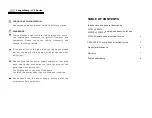
Page 22
www.omlet.co.uk
What to do if a bee gets in your suit?
There are several things you can do to avoid being stung.
•
Always wear a beesuit when working with bees. Wear long sleeved
tops and trousers underneath as a suit on it’s own is not always
100% effective against a bee sting.
•
Wear wellington boots over your beesuit. Bees crawl upwards so
it’s always better to tuck clothing in rather than leave it out.
• Don’t stand in front of the hive entrance where the bees are flying.
• Don’t wear shiny jewellery.
• Don’t stand near the hive after eating strong smelling food or alcohol
eg curry.
• Bananas are particularly offensive to bees, so avoid them.
• Don’t use scented soap, cosmetics or fabric conditioner.
• Don’t let visitors wander over to the hive without a beesuit on.
If a bee gets into your hair, the best thing to do is to calmly and quickly
squash it by whacking your hand on top. Our hair is like velcro to a bee
and they find it almost impossible to get out.
If a bee gets in your suit, quickly but calmly walk away from the hive.
It is often quite hard to release a bee from your suit and the most
straightforward way of dealing with it is unfortunately to squash
the bee.
you should never open your veil next to a hive of bees.
Smoking your gloves
If a bee does sting on your gloves or suit while inspecting your hive this
can encourage further bees to sting the same area. You can stop this
happening by smoking the area with either liquid smoke or traditional
smoke. This masks the smell of the sting from other bees. You should
also wash your suit and gloves regularly as the alarm smell can remain for
several weeks in clothes.
Spray your gloves with a liquid smoker.
Dealing with a sting
If you are stung, you should scrape
the sting and bee away using the
hive tool or a finger nail. You should
avoid squeezing the bee or sting as
this will force more venom into you.
Spray the area with a little liquid
smoke to disguise the smell which
otherwise would attract more bees.
A normal reaction
A normal reaction to a bee sting is for the area around the sting to be
itchy and red immediately after the sting. This itching sensation goes
away within a couple of hours. The area may then also swell up 2-3 times
the normal size. The swelling can occur up to 24 hrs later and last up to
72 hours. You can reduce the itching by applying an antihistamine cream
to the sting. The swelling can also be reduced by using an antihistamine
tablet, however, please check with your doctor or pharmacist if this is
suitable for you and be aware that some antihistamines make you drowsy
as a side effect.
A severe reaction
A severe reaction will produce an even bigger swelling with persistent
pain around the area. If this happens you should seek medical attention.
An extreme reaction
A tiny percentage of people are extremely allergic to bee
stings and even just one sting can be fatal, therefore you
should learn to recognise the signs. The reaction can be treated
with adrenaline, but time is of the essence as the person can
be unconscious within 10 minutes. The immediate signs of an extreme
reaction to look out for are:
• Confusion or anxiety
• Dizziness
• Metallic taste in the mouth
• Abnormal breathing
• Fainting
• Itching or red, blotchy skin anywhere else on the body other than the
sting site.
If you or someone you are with has any of these symptoms you should
call 999 immediately and ask for the ambulance.
If you have been working with the bees, you must close the hive and
move the person affected away from the area with bees. Put the person
affected in the recovery position.
Even if you are not allergic to bee stings if you are stung in the mouth
or nose you should seek urgent medical attention as swelling may block
airways.
Unfortunately, there is no way around it - as a beekeeper you will get
stung from time to time. Although bees are not aggressive creatures, they
can be understandably defensive of their home. You can generally tell if
a bee is becoming defensive. It will fly around you and produce a high
pitched buzzing. If you are not in your beesuit then you should calmly
walk away.
Bee stings and how to avoid them
Scrape the sting with your hive tool.
Stop a bee chasing you by going under
a tree.
After you have inspected your Beehaus, you may find that the odd guard
bee will continue chasing you after you have left the hive. You can stop
them from following you by:
1. Squirting them with liquid smoke to confuse them.
2. You can also try standing in amongst the branches of a tree or bush.
Although you might look slightly silly, it really is quite effective.
How to stop a bee chasing you
What happens to a bee when it stings you?
Sadly bees usually die after they have stung you, but not always. The bee’s
sting evolved as a means of defending the hive from other insects’ intent
on stealing honey and larvae. When a bee stings a wasp, the sting can
be extracted again without damaging the bee. However, our skin is
much more elastic and it is almost impossible for the bee to remove it.
The bee flies away and dies from dehydration as her body can no longer
retain liquid.
















































